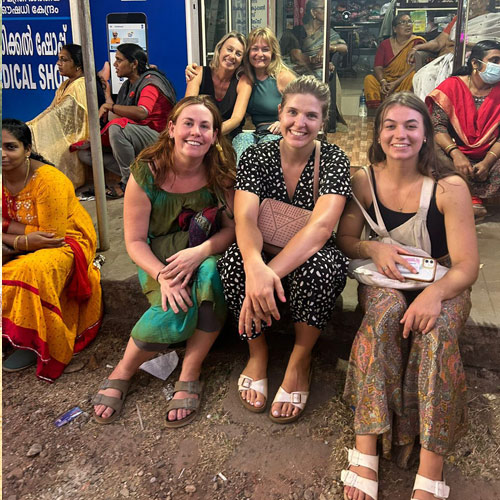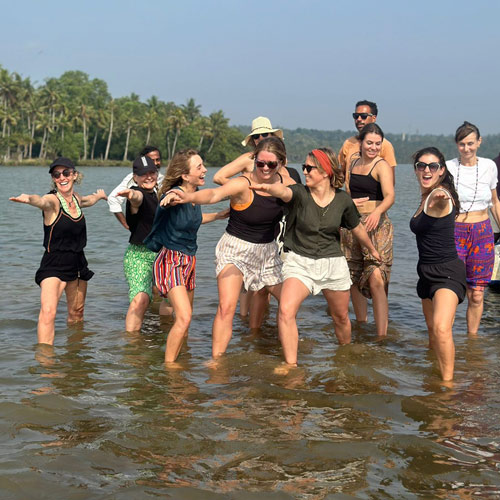We all feel different body reactions to our varied emotions. For instance, you might feel queasy in the stomach when you are nervous or anxious. Similarly, there is also stiffness around the neck and shoulder area when we are under stress. Also, most of us feel a lump in our throats when we are crying. All these only point to one thing; that our emotions affect specific parts of our bodily system.
However, in yogic parlance, this association between our mind and emotions can be attributed to the 7 chakras that dwell in our body.
But, before we go about explaining how to activate chakras in the human body, we must understand what these Chakras are and their effect on our system.
What are these 7 Chakras?
To begin with, a Chakra denotes a wheel in the Indian Sanskrit language. It denotes an energy point or life force (prana) that runs through the varied parts and systems of our body. These are the veins, arteries and nerves.
During early periods, Chakras denoted energy in its varied forms. Also referred to as a focal point especially while meditating, these Chakras gained traction so as to activate the Kundalini or the hidden life force that resides in every being. It is believed that we as humans are made up of 7 Chakras that can be harnessed through the power of yoga.
Yogic interventions such as Mantra chanting, certain Mudras and certain yoga asanas are believed to activate these innate Chakras.
It’s worthwhile to note that each individual Chakra comes with its own set of unique Mantras and Mudras that have the potential in activating the 7 Chakras.
Now, let’s discuss each of these 7 Chakras in some more detail before we further delve into sections that talk about how to activate chakras in the human body.
The 7 focal energy Centres (Chakras)
As explained in the above sections, our human body consists of 7 Chakras or focal energy points that run down or flow through our bodies. These Chakras have the ability to offer energy for our different body functions therein affecting our mind, body and intellect.
As per yogic understanding, every such Chakra comes with its own energy and binds closely with our spiritual as well as emotional health.
We will now define each Chakra and its role in the human body.
The Muladhara or Root Chakra
This root Chakra is located at a point where our spine ends. Alternatively, its situated at the tail of our spine. The Muladhara controls our survival or basic human instincts.
The Svadhisthana or Sacral Chakra
The Svadhisthana or the Sacral Chakra as the name suggests is present just below in the navel or belly button area. This Chakra governs our creative and sexual energy. This sacral Chakra also works in how we connect with others emotionally.
The Manipura or Solar Plexus Chakra
Above the Sacral Chakra lies the Manipura. This solar plexus Chakra governs the area of the stomach and is responsible for maintaining our digestive health. Also, this Chakra also relates with our self confidence, self-respect, fear and such other emotions.
The Anahata or Heart Chakra
Located at the centre of the heart, this Chakra as the name itself suggests governs emotions such as compassion, love, gratitude and devotion.
The Vishuddha or throat Chakra
As the name suggests the Anahata Chakra is located in the throat area. This Chakra specifically governs attributes of communication, self-expression and how we respond verbally to others.
The Ajna or the Third Eye Chakra
As the name suggests the third eye Chakra is responsible for your gut instinct or what we call as intuition. Located between the eyebrows, this Chakra entails response when faced with challenging situations.
The Sahasrara or the Crown Chakra
Perched at the top of the head, this Chakra denotes the purpose of our life as well as how we form spiritual connection to ourselves, others and the universe at large.
Now that we have a fair idea about the meaning of Chakras and the significance of each of the Chakras, we will now move on to how to actually activate the Chakras in the human body.
How to activate Chakras in the human body?
Each of these seven Chakras relate to specific areas and parts of the human body. However, to use these Chakras, they need to be activated and balanced so as to maintain the physical and emotional balance of our bodies.
This can be attained through the practice of yoga asanas and certain Mudras and Mantras. Consistent practice of these yogic elements can help achieve balance. Furthermore, it can also work to enhance energy levels as well as elicit certain bodily responses.
Balancing Chakras with Yoga Asanas
As explained above, yoga asanas is a vital part of the Chakra balancing activity for the human body. Now, let’s discuss some of these asanas in brief and their role in how to activate chakras in the human body.
Some of the yoga asanas or postures for balancing the 7 Chakras are enlisted below. Let’s take a look.
Tadasana or Mountain Pose for Root Chakra
The Tadasana is a simple yet effective asana for opening the Muladhara or the root Chakra. This grounding pose helps to activate the centre of energy that is believed to be located at the base of the spine. This pose when performed correctly helps you to remain grounded and living fully for the present moment. Besides, this asana has several health benefits as it improves balance and coordination, improves posture and strengthens hips, back and the legs.
Setu Bandhasana or Bridge Pose for Sacral Chakra
This is a highly dynamic asana that helps to ground your feet firmly on the floor therein allowing your spine to expel excess energy of the root chakra. Besides, the Bridge pose also helps open up the throat chakra as it activates the heart and the solar plexus chakras.
Talking about the physical benefits of the mountain pose, it helps enhance blood circulation and digestion. Also, the pose when done correctly is beneficial for the abdominal organs, the lungs and the thyroid glands.
Virabhadrasana or Warrior pose for Solar Plexus Chakra
This standing asana has a multi-pronged effect in activating not only solar plexus chakra but also opening up the root chakra as well as the sacral chakra. This pose helps shift the vital energy force in the body while harnessing this energy to feel connected and empowered.
Physically, the Warrior pose helps build strong legs, lower back and knees while opening up the hips. Also, the pose helps enhance concentration, stability and balance.
Matsyasana or fish pose for heart chakra
The fish pose helps to release the negative energy stored in the chest area while helping in emotional healing. Talking about the physical benefits, this pose helps to reduce fat from the abdominal area while promoting respiration and relieving stress.
Chakravakasana or cat-cow pose for throat chakra
The cat-cow pose helps activate the throat chakra. Also, since this pose involves several poses, it also helps open up the root chakra, the solar plexus chakra and the sacral chakra.
When done correctly, this pose helps feel grounded and secure while also helping release negative emotions of shame and anger.
Vrikshasana or tree pose for third eye chakra
The Vrikshasana is a balancing pose that helps to open up the Ajna or the third eye Chakra. It helps improve focus while enhancing our gut instinct.
Adho Mukha Svanasana or the Downward facing dog pose for Crown Chakra
As the crown Chakra is located at the top of the head, inversion and balancing poses work well in energising this area. Since in this pose, the head is at a lower level than the heart, it helps improve blood flow to the head region. Also, this pose helps relieve tension in the neck and head area.
Besides these asanas, there are a plethora of asanas that work to energise a number of chakras, sometimes simultaneously.
Chakra balancing through Mudras
Besides the yoga asanas, there are various mudras that also help in opening up the Chakras through releasing the vital energy force or prana in the body. Now, let’s discuss how to perform these mudras and their role in how to activate chakras in the human body.
These mudras are enlisted below:
Muladhara
Be seated in a comfortable position and keep your spine erect. Fold your palms in a Namaste mudra while placing it in front of the heart. Interlace the ring fingers and the little fingers so as to fold them inside of your palms.Inhale and exhale deeply for about 7 to 10 breaths.
Swadishthana
Sit in a comfortable position by keeping your spine erect. Now, focus your attention to an area located just below your navel and the lumbar vertebra 1. Rest your right hand on your left one while keeping your palms facing upwards on your lap as your thumbs slightly touch. Inhale and exhale deeply for about 7 to 10 breaths.
Manipura
Sit with your spine erect while focussing your attention towards the navel area and the thoracic vertebra-8. Keep your fingers straight and point in the forward direction while touching at the top. While keeping your thumbs crossed in a V with the left thumb below the right one. Repeat for about 10 breaths.
Anahata
Focus your attention across the thoracic vertebra-1 while sitting with your spine erect. Form a circle with your thumb and forefingers. Rest your left-hand palm on your left knee. Raise your right hand towards the middle of your chest and hinge your palms towards the direction of your heart. Inhale and exhale deeply for about 7 to 10 breaths.
Vishuddhi
Sit comfortably with an erect spine and focus attention to an area at the fag end of your throat across the cervical vertebra-3. Form a circle with the help of your thumbs touching while your rest of the fingers loosely crossed and cupped. Raise your hands at the forefront of the solar plexus and throat. Alternatively, rest your hands on your lap. Inhale and exhale deeply for about 7-10 breaths.
Ajna
Focus your attention on your crown area while keeping your spine erect. The focal point should stretch from your eyebrows across to cervical vertebra-1 and the outer part of your skull. Touch your thumbs at their tips and form a heart shape with the help of your forefingers, ring finger and pinky finger. This way you will do a crown formation. Raise your hands in front of the solar plexus area and the crown. Also, you can keep them simply resting in your lap. Inhale and exhale deeply for about 7-10 breaths.
Sahasrara
Sit in a comfortable manner by keeping your posture erect. Now, focus your attention on your crown above your head and about three inches above your skull. Keep your fingers crossed inside your left thumb below the right while clasping your hands. Raise your hands over your head in front of the solar plexus region. Inhale and exhale by taking deep breaths for about 7 to 10 times.
Regularly performing the asanas alongwith the mudras can help in activating the chakras in the human body and entail positive results for the mind and the body.
Mantras for activating the 7 chakras in the human body
There are a set of Mantras that, when chanted correctly, can activate the Chakras. This chanting can be done in your own voice. However, it should be noted that a low-pitched or a high-pitched voice during Mantra chanting is not suitable for activating these Chakras.
● Chant ‘LAM’ for Muladhara Chakra
● Chant ‘VAM’ for Swadishthana Chakra
● Chant ‘RAM’ for Manipura Chakra
● Chant ‘YAM’ for Anahita Chakra
● Chant ‘HAM’ for Vishuddhi Chakra
● Chant ‘OM’ or ‘AUM’ for Ajna Chakra
● Chant ‘OM’ or ‘AH’ for Sahasrara Chakra
Pranayama to activate Chakras in the human body
Pranayama is a controlled breathing technique that energises your entire being. This chakra purifying and balancing pranayama helps remove various imbalances and toxins from the human body. Some of the most effective pranayama for activating the chakras in the human body are enlisted below:
- Kapalbhati pranayama or skull shining
- Anulom Vilom or alternate nostril breathing
- Full yogic breath
- Pranayama involving deep abdominal breathing
Other Chakra balancing Interventions
Besides performing the yoga asanas, chanting mantras and performing mudras, you can also balance chakras by other means. Things like sound healing, practising visualisation, Chakra colour meditation and imbibing nature into your daily routine can all have a soothing effect in activating the 7 chakras in the human body.
Wrapping up
The Chakras can be looked upon as different steps embedded in the ladder of consciousness. So, activating all of these 7 Chakras requires a concerted effort and a holistic transformation of consciousness. Furthermore, simply focussing only on the physical aspects such as asanas would only help gain results in the physical realms. Hence, all aspects of Chakra awakening involving the asanas, mantra chanting, mudras and practising Kundalini awakening pranayama together will harness the inner potential of the human body and the innate Kundalini power will awaken.











